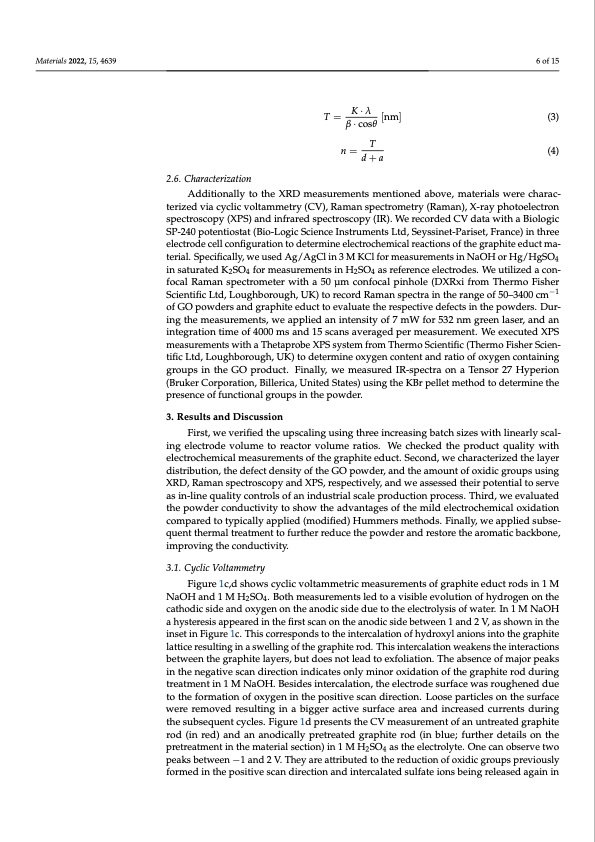
PDF Publication Title:
Text from PDF Page: 006
Materials 2022, 15, 4639 6 of 15 T= K·λ [nm] β·cosθ n= T d+a (3) (4) 2.6. Characterization Additionally to the XRD measurements mentioned above, materials were charac- terized via cyclic voltammetry (CV), Raman spectrometry (Raman), X-ray photoelectron spectroscopy (XPS) and infrared spectroscopy (IR). We recorded CV data with a Biologic SP-240 potentiostat (Bio-Logic Science Instruments Ltd, Seyssinet-Pariset, France) in three electrode cell configuration to determine electrochemical reactions of the graphite educt ma- terial. Specifically, we used Ag/AgCl in 3 M KCl for measurements in NaOH or Hg/HgSO4 in saturated K2SO4 for measurements in H2SO4 as reference electrodes. We utilized a con- focal Raman spectrometer with a 50 μm confocal pinhole (DXRxi from Thermo Fisher Scientific Ltd, Loughborough, UK) to record Raman spectra in the range of 50–3400 cm−1 of GO powders and graphite educt to evaluate the respective defects in the powders. Dur- ing the measurements, we applied an intensity of 7 mW for 532 nm green laser, and an integration time of 4000 ms and 15 scans averaged per measurement. We executed XPS measurements with a Thetaprobe XPS system from Thermo Scientific (Thermo Fisher Scien- tific Ltd, Loughborough, UK) to determine oxygen content and ratio of oxygen containing groups in the GO product. Finally, we measured IR-spectra on a Tensor 27 Hyperion (Bruker Corporation, Billerica, United States) using the KBr pellet method to determine the presence of functional groups in the powder. 3. Results and Discussion First, we verified the upscaling using three increasing batch sizes with linearly scal- ing electrode volume to reactor volume ratios. We checked the product quality with electrochemical measurements of the graphite educt. Second, we characterized the layer distribution, the defect density of the GO powder, and the amount of oxidic groups using XRD, Raman spectroscopy and XPS, respectively, and we assessed their potential to serve as in-line quality controls of an industrial scale production process. Third, we evaluated the powder conductivity to show the advantages of the mild electrochemical oxidation compared to typically applied (modified) Hummers methods. Finally, we applied subse- quent thermal treatment to further reduce the powder and restore the aromatic backbone, improving the conductivity. 3.1. Cyclic Voltammetry Figure 1c,d shows cyclic voltammetric measurements of graphite educt rods in 1 M NaOH and 1 M H2SO4. Both measurements led to a visible evolution of hydrogen on the cathodic side and oxygen on the anodic side due to the electrolysis of water. In 1 M NaOH a hysteresis appeared in the first scan on the anodic side between 1 and 2 V, as shown in the inset in Figure 1c. This corresponds to the intercalation of hydroxyl anions into the graphite lattice resulting in a swelling of the graphite rod. This intercalation weakens the interactions between the graphite layers, but does not lead to exfoliation. The absence of major peaks in the negative scan direction indicates only minor oxidation of the graphite rod during treatment in 1 M NaOH. Besides intercalation, the electrode surface was roughened due to the formation of oxygen in the positive scan direction. Loose particles on the surface were removed resulting in a bigger active surface area and increased currents during the subsequent cycles. Figure 1d presents the CV measurement of an untreated graphite rod (in red) and an anodically pretreated graphite rod (in blue; further details on the pretreatment in the material section) in 1 M H2SO4 as the electrolyte. One can observe two peaks between −1 and 2 V. They are attributed to the reduction of oxidic groups previously formed in the positive scan direction and intercalated sulfate ions being released again inPDF Image | Electrochemical Production Thermal Reduction Graphene Oxide

PDF Search Title:
Electrochemical Production Thermal Reduction Graphene OxideOriginal File Name Searched:
materials-15-04639.pdfDIY PDF Search: Google It | Yahoo | Bing
Salgenx Redox Flow Battery Technology: Power up your energy storage game with Salgenx Salt Water Battery. With its advanced technology, the flow battery provides reliable, scalable, and sustainable energy storage for utility-scale projects. Upgrade to a Salgenx flow battery today and take control of your energy future.
| CONTACT TEL: 608-238-6001 Email: greg@infinityturbine.com | RSS | AMP |